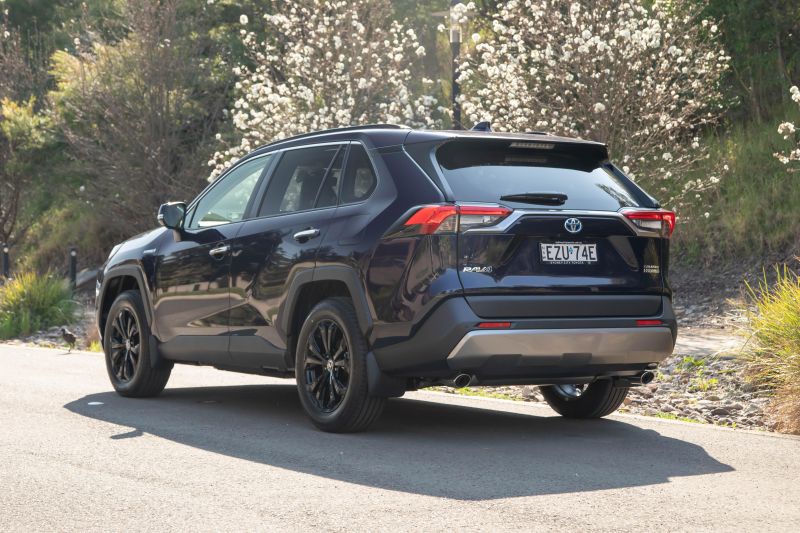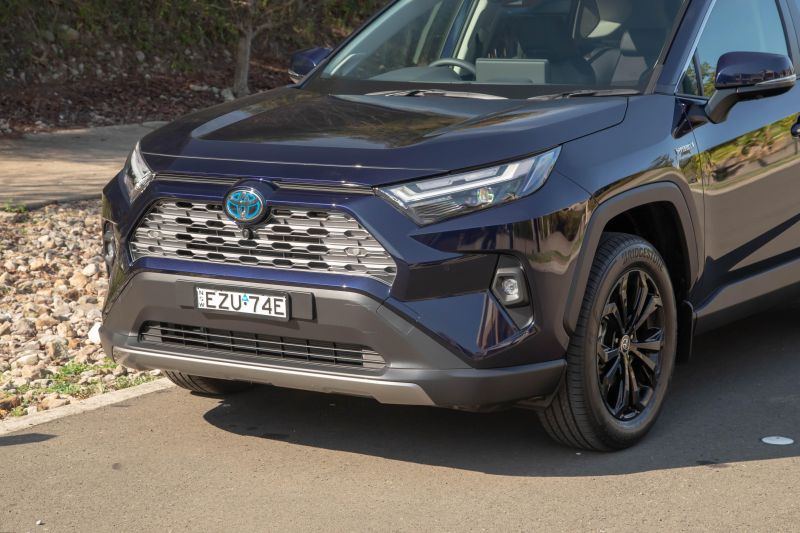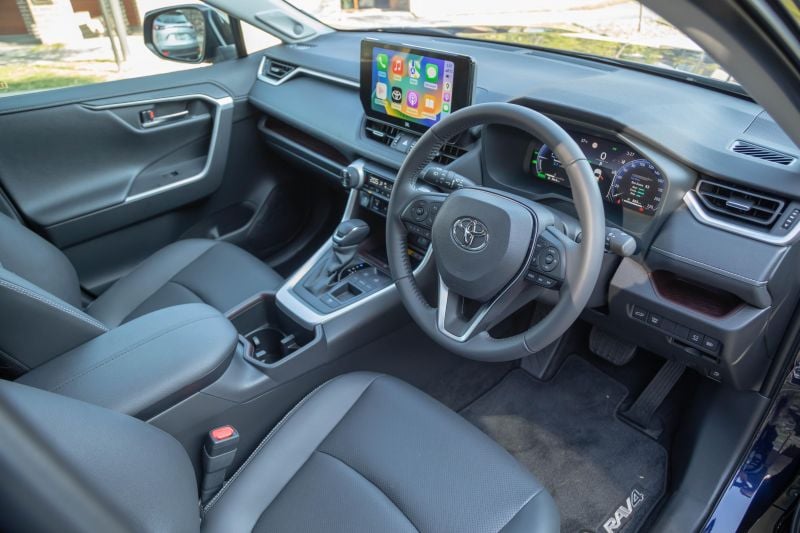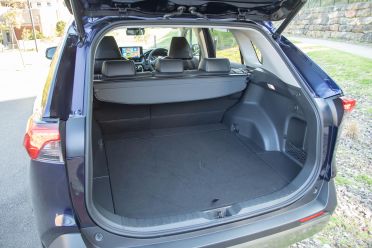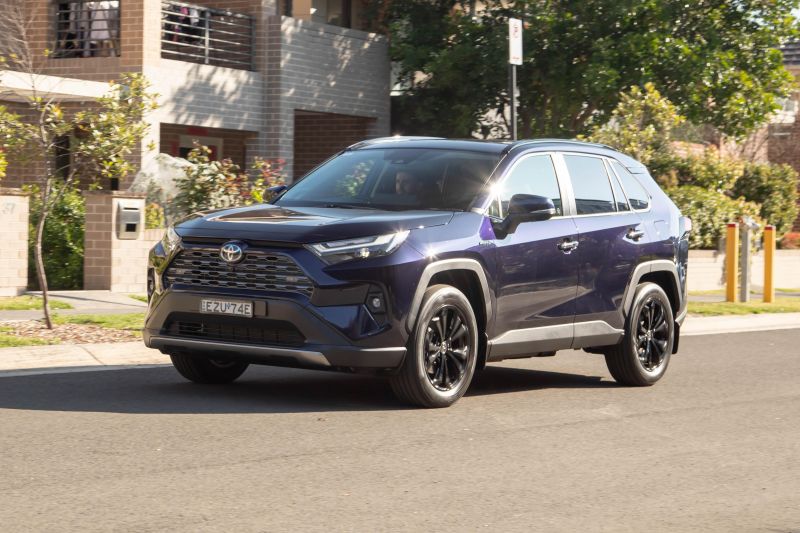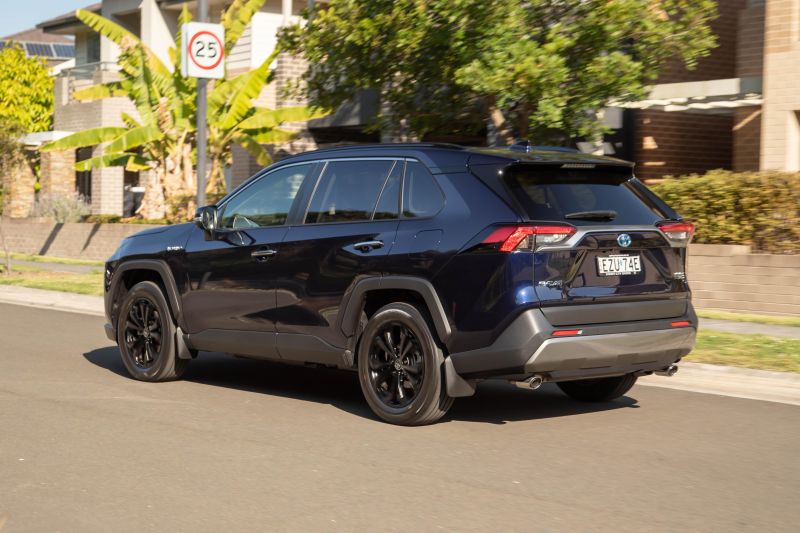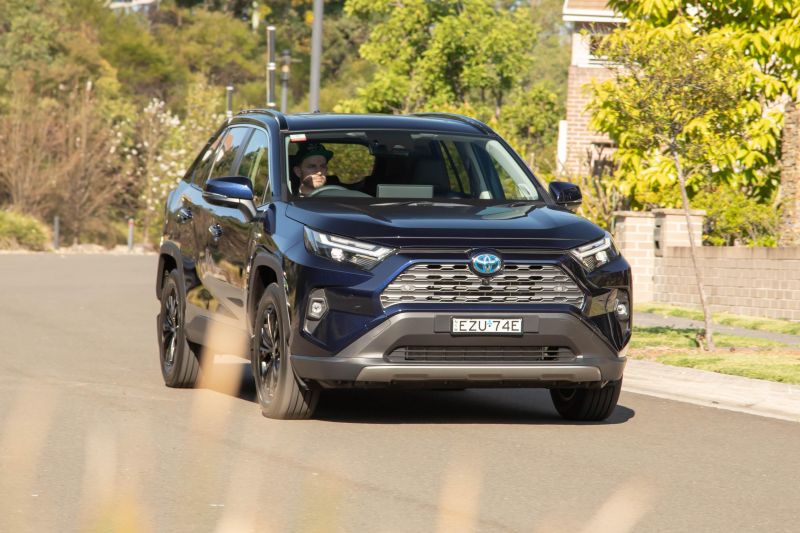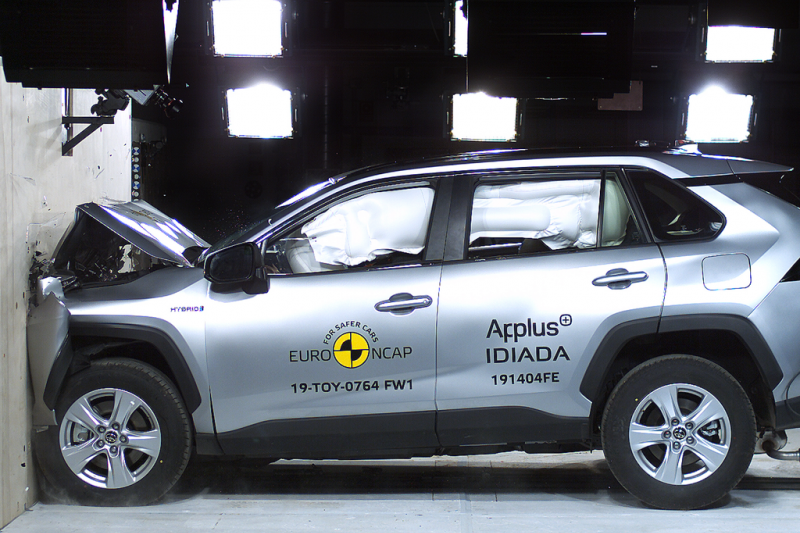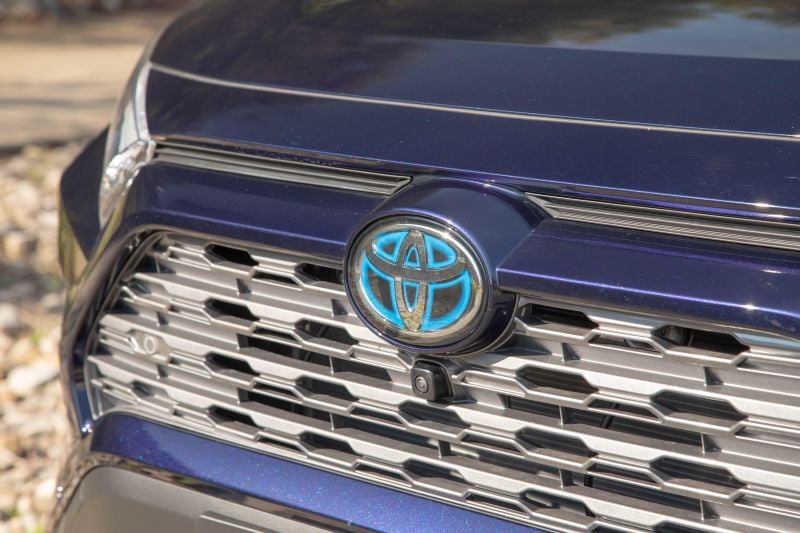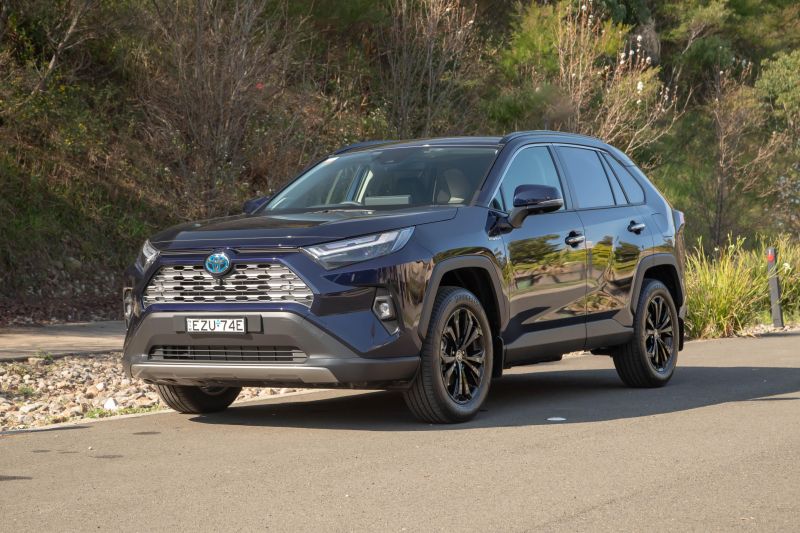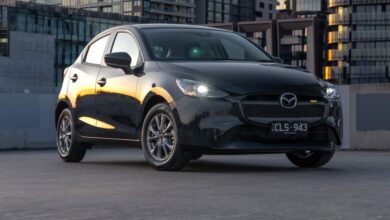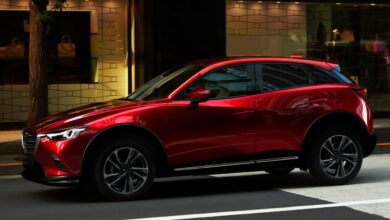2024 Toyota RAV4 Hybrid review

People are willing to wait months, even years for a Toyota RAV4 Hybrid, especially Cruiser spec as tested here.
Is it worth the wait? This mid-sized SUV offers a lot of positive traits, terrific real-world efficiency, and it’s a very good size: offering plenty of practicality for growing families.
Let’s run through why I think this is still one of the best, if not the best medium SUVs on the market.
How much does the Toyota RAV4 Cruiser 2WD Hybrid cost?
Let’s also contextualise the original start price for this generation RAV4 Cruiser 2WD Hybrid – back at launch in 2019, this spec was $41,140 plus on-road costs. Today? It’s $51,410 before on-roads.
I know a lot has happened in the market (and the world since those simpler times) but that does give you some indication that its value equation isn’t quite as strong as it was. There is at least still a heap of good gear in standard specification, and the most recent update has seen some included new stuff, which I’ll detail further down.
However, it is probably worth considering some of the rivals the RAV4 competes against, and what you might want to cross-shop this hybrid high-spec model against. Firstly, there’s the GWM Haval H6 Ultra Hybrid, which at $45,990 drive-away, offers strong value for money. It’s also the pick of the H6 line-up in terms of the drive experience too.
Another model you might want to consider if hybrid tech is your interest is the Nissan X-Trail e-Power, which in Ti spec is a $54,690 proposition. It doesn’t do ‘hybrid’ the same way the RAV4 or H6 do. Instead, it uses its petrol engine purely as a generator, and there’s a battery pack and electric motors to propel the car. Different, but interesting!
MORE: Haval H6 Hybrid v Toyota RAV4 Hybrid comparison
Toyota RAV4 pricing:
- Toyota RAV4 GX 2WD: $39,760
- Toyota RAV4 GX 2WD Hybrid: $42,260
- Toyota RAV4 GX AWD Hybrid: $45,260
- Toyota RAV4 GXL 2WD: $43,310
- Toyota RAV4 GXL 2WD Hybrid: $45,810
- Toyota RAV4 GXL AWD Hybrid: $48,810
- Toyota RAV4 XSE 2WD Hybrid: $49,585
- Toyota RAV4 XSE AWD Hybrid: $52,585
- Toyota RAV4 2WD Cruiser: $48,910
- Toyota RAV4 Cruiser 2WD Hybrid: $51,410
- Toyota RAV4 Cruiser AWD Hybrid: $54,410
- Toyota RAV4 Edge AWD: $56,230
- Toyota RAV4 Edge AWD Hybrid: $58,360
Prices are before on-road costs
What is the Toyota RAV4 Cruiser 2WD Hybrid like on the inside?
I’ve long been a fan of the interior of the Toyota RAV4; it blends smart design, clever storage, simple controls, as well as quality fit and finishes. This makes for a really likeable, comfortable family space.
New to the recently-updated RAV4 is the addition of a larger touchscreen media system. This makes the interior feel a touch more modern in the higher-spec versions than the 8.0-inch screen still available in cheaper grades.
The new 10.5-inch touchscreen sits a little prouder, with a higher-resolution, brighter display, but sadly without the physical buttons on the edges of the screen. It’s also has a slightly more confusing (well, until you’re used to it) screen menu system with a few hidden elements that aren’t as simple to adjust as they could be, such as the sound settings for bass, treble and fader, for example.
Thankfully, it’s pretty easy to get to grips with – especially if you’re like me and usually just use Apple CarPlay to interact with the screen. The JBL sound system is pretty good too. And while there’s built-in sat nav, in my experience it can be a little bit laggy as to your current position and the instruction coming up, so you might find you miss a few turns if you rely on it.
There’s also a new digital instrument cluster in this spec. It is crisp, colourful and more modern than the previous version. It’s easy to use and the info on display is useful and manageable in terms of moving through the menus using the steering wheel controls.
In fact it’s the controls that make the RAV4 simple to live with, as none of the crucial stuff is buried in the media screen. There’s a pair of big rubberised dials for climate control, while fan and air-conditioning controls all fall easily to hand too. Plus, in this spec, you get the heated and ventilated (cooled) seat buttons in that same area as well.
While the driver’s seat comfort and adjustment is good, taller people might find the passenger seat to be too high, and it doesn’t have height adjustment. My brother-in-law is 6’4” (193cm) and he struggles to fit there when his partner is driving.
Storage is excellent in the RAV4 with the big shelf in front of the passenger offering a good space for stuff. There are also good nooks near the gear selector (including a 50-cent-piece-sized section which is apparently great for putting your garage or gate fob), and there are big cup holders as well as a covered centre console bin. Front occupants also get large door pockets with bottle holders.
Front-seat riders might appreciate the small sunroof, but it’s tiny by modern standards.
The rear seat accommodation easily has enough space for an adult my size (182cm/6’0”) to fit behind my own driving position. There’s a decent amount of width to the seat as well, so three adults across is possible. Headroom is generous, knee room good, and toe room fine.
If you have younger occupants there are ISOFIX points in the window seats, three top-tether points and directional air-vents and USB charging to keep those in the back happy.
Plus, there is a storage pocket (just one), flip-down arm-rest with cup-holders and bottle holders in the doors.
The RAV4 is exclusively a five-seater, so some buyers might be left looking for alternatives with three rows of seats. If you need those the larger Kluger is an enlarged version of this… otherwise best to look at a CR-V, Outlander or X-Trail.
The boot is another plus, with 580 litres of cargo capacity. There’s easily enough space for a family to head away for a weekend in the RAV4. I’ve done it with my daughter, two dogs and a bootfull of stuff, and the car did fine.
There’s a space-saver spare wheel in this grade, and an adjustable boot floor to allow just a wee bit more depth to the space (it’s 580L in that setup or 542L with the floor at standard height). Fold the rear seats down, and there’s 1690L of capacity.
What’s under the bonnet?
Toyota RAV4 2WD Hybrid models pair a 2.5-litre naturally aspirated petrol engine with an electric motor and small battery pack, good for a system output of 160kW. It uses an e-CVT (continuously variable transmission).
Choose the AWD model and you get an additional ‘eFour’ electric motor at the rear axle, and power bumps to 163kW.
However, if you don’t want to wait months (years, possibly) for a RAV4 Hybrid, there’s also a better-than-average 2.0-litre four-cylinder petrol engine (127kW/203Nm) with a CVT auto and front-wheel drive. It’s a pretty good urban runner, and has decent real-world efficiency on it side too.
Just keep in mind that if you need to tow, this might not be ideal for you. Maximum towing capacity is just 480kg in 2WD Hybrid models like this one (including braked towing). Unbraked towing capacity is 750kg for all others, while braked towing maxes out at 800kg in 2.0-litre models, and 1500kg in AWD Hybrid and 2.5-litre petrol models.
How does the Toyota RAV4 Cruiser 2WD Hybrid drive?
The RAV4 does it right for families who are after a predictable, comfortable, and even enjoyable SUV to live with – it nails the brief.
The hybrid powertrain is powerful enough (even with five onboard) and has some serious smarts when it comes to choosing whether to run in EV mode, use the petrol engine, or use a combination of the two.
It will often flick to EV when you’re coasting around town, or even use battery power to pull you away from a standstill. And there’s also the chance you will find the car running electric (there’s a green indicator on the screen to prove it) when you’re driving on the highway, using light throttle.
It does make a bit of racket when you have the engine kicking in under hard throttle, and it can be a bit noisy at idle when it’s cold, I should add. But I think the noise is more noticeable because it often runs in near-silent EV mode.
It’s not totally silent, of course – there’s some noise intrusion from the tyres at some speeds on some surfaces, but the most intrusive sound in the cabin is actually wind rush around the mirrors/windscreen up front.
The driving manners of the RAV4 are really good too, with sweet, natural feeling steering that is well weighted and easy to judge for parking moves or at pace.
The suspension also deals really well with lumpy roads and sharp edges too. It’s definitely comfortable as a family car, and as a commuter.
Speaking of commuting, the active safety technology is well sorted in the RAV4 – with a pretty subtle lane-keeping assistance system for highway driving, and stop-start cruise control to take the pain out of low-speed traffic snarls.
That said, I still turned the lane-keeping tech off every time I drove it, because I prefer the steering to be my responsibility.
Keep in mind though, if you choose the front-drive hybrid you may find the front tyres can be overwhelmed with the amount of torque on offer, especially on slippery surfaces.
If you frequent those a lot – gravel tracks, icy or snowy roads, or maybe it just rains a lot where you are – the extra spend for all-wheel drive might be worthwhile.
What do you get?
RAV4 Cruiser highlights:
- 18-inch alloy wheels (Hybrid)
- 19-inch alloy wheels (Petrol)
- Projector-type LED headlights
- LED daytime running lights
- LED front fog lights
- Auto power-folding mirrors
- Power sunroof
- 10-way power driver’s seat incl. memory
- 8-way power passenger seat
- Heated, ventilated front seats
- Leather upholstery
- Ambient lighting
- 9-speaker JBL sound system
- Surround-view camera
- Digital rear-view mirror
- 10-way power adjustment incl. lumbar support (driver)
- 12.3-inch digital instrument cluster
- 10.5-inch infotainment with sat nav
- incl. Toyota Connected Services
- Apple CarPlay (wired, wireless)
- Android Auto (wired only)
- DAB+ digital radio
- 3 x front and 2 x rear USB ports
- Keyless entry
- Push-button start
- Power tailgate
- Automatic high-beam
- Automatic headlights
- Rain-sensing wipers
- Heated, power-folding exterior mirrors
It’s easy to see why people gravitate to this grade, though keep in mind you can’t get a Cruiser with the panoramic glass roof that is an option in the top-spec Edge.
Is the Toyota RAV4 safe?
The RAV4 achieved the maximum five-star ANCAP safety rating in 2019, and it’s valid until December 2025.
The score breakdown saw the RAV4 achieve 93 per cent for adult occupant protection, 89 per cent for child occupant protection, 85 per cent for vulnerable road user protection, and 83 per cent for safety assist.
The following safety features are standard across the range:
- Autonomous emergency braking (AEB)
- Pedestrian/daytime cyclist detection
- Intersection Turn Assist
- Adaptive cruise control
- Blind-spot monitoring
- Lane departure warning
- Lane Tracing Assist
- Rear cross-traffic alert
- Reversing camera
- Front, rear parking sensors
- Traffic sign recognition
- Trailer sway control
- Emergency Steering Assist
- Hill-start Assist Control
- 7 airbags incl. front, front side, full length curtain and driver’s knee airbag
If you buy the Cruiser or Edge you get a 360-degree surround-view camera, while other specs get a reversing camera.
Weirdly, though, the Edge alone has active rear cross-traffic assist and low-speed reverse AEB, which I think ought to be standard more widely.
How much does the Toyota RAV4 Cruiser 2WD Hybrid cost to run?
All Toyota models come with a five-year, unlimited-kilometre warranty, but if you make sure you maintain logbook servicing (with Toyota or other approved mechanics) you can get up to seven years of powertrain cover.
If you service under Toyota’s Hybrid powertrain protocols, petrol-electric models will also have a health-check every 12 months, which will warranty cover the battery pack for up to 10 years.
Service intervals are 12 months/15,000km, which is good, and the service cost is part of a capped-price plan for the first five years/75,000km, with an average maintenance cost during that period of just $260.
In over a week of driving I managed 5.7 litres per 100km. To achieve this the engine and electric motor did their best work together to try and save fuel and regen braking added potentially lost energy back to the nickel-metal hydride battery pack, just like it does in a pure electric car.
RAV4 fuel consumption (claimed):
- Toyota RAV4 2WD Hybrid: 4.7L/100km
- Toyota RAV4 AWD Hybrid: 4.8L/100km
- Toyota RAV4 2.0L 2WD: 6.0L/100km
- Toyota RAV4 2.5L AWD: 7.0L/100km
CarExpert’s Take on the Toyota RAV4 Cruiser 2WD Hybrid
If you can wait, it’s totally worth it in my opinion. The Toyota RAV4, particularly in Cruiser Hybrid spec, makes a lot of sense for buyers who want an efficient, well-packaged, comfortable and likeable family SUV.
My tip would be to also consider the XSE, if you don’t want to wait as long for the Cruiser.
Don’t just rely on your local dealership to find a RAV4 Hybrid either: call around to regional and remote stockists as you might find there are cars out there you never knew about!
Click the images for the full gallery
BUY: Toyota RAV4
MORE: Everything Toyota RAV4
